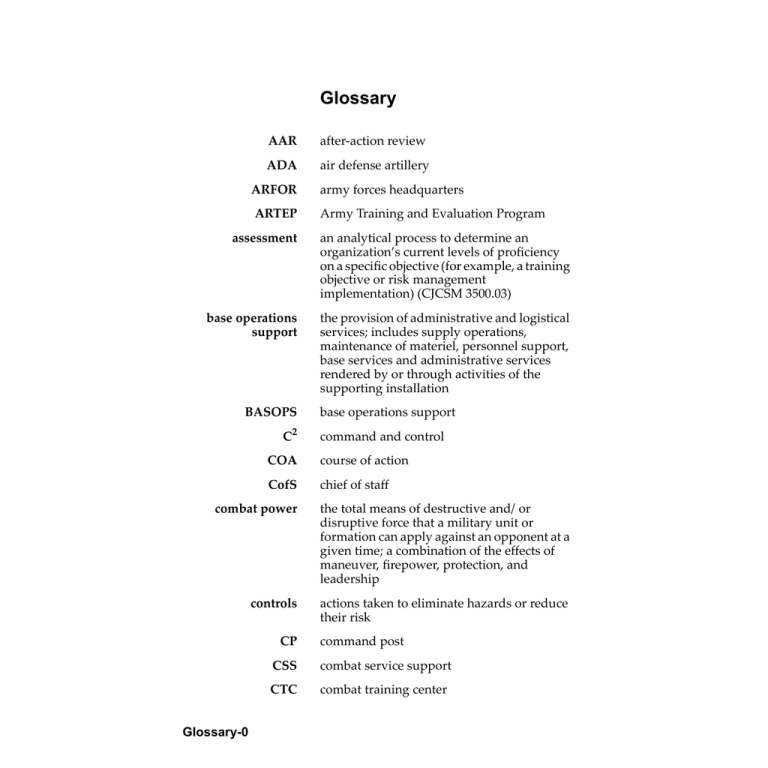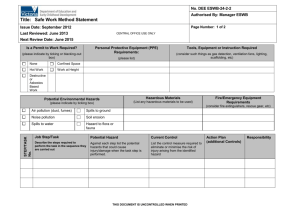Glossary
advertisement

Glossary AAR after-action review ADA air defense artillery ARFOR army forces headquarters ARTEP Army Training and Evaluation Program assessment an analytical process to determine an organization’s current levels of proficiency on a specific objective (for example, a training objective or risk management implementation) (CJCSM 3500.03) base operations support the provision of administrative and logistical services; includes supply operations, maintenance of materiel, personnel support, base services and administrative services rendered by or through activities of the supporting installation BASOPS C2 base operations support command and control COA course of action CofS chief of staff combat power the total means of destructive and/or disruptive force that a military unit or formation can apply against an opponent at a given time; a combination of the effects of maneuver, firepower, protection, and leadership controls actions taken to eliminate hazards or reduce their risk CP Glossary-0 command post CSS combat service support CTC combat training center FM 100-14 danger EAC evaluation exposure FM FRAGO fratricide friction FSO G3 exposure or vulnerability to harm or risk; the balance between the chance or probability of a hazardous incident and the result of the hazardous incident echelons above corps the process used to measure the demonstrated ability to accomplish specified objectives such as training within a discrete event or exercise (CJCSM 3500.03); measurement of the demonstrated ability of soldiers or units to perform a task and supporting skill and knowledge or learning objective against the established standard the frequency and length of time personnel and equipment are subjected to a hazard field manual fragmentary order the employment of friendly weapons and munitions with the intent to kill the enemy or destroy his equipment or facilities, which results in unforeseen and unintentional death or injury to friendly personnel the accumulation of chance errors, unexpected difficulties, enemy actions, and confusion of battle fire support officer general staff operations section hazard any actual or potential condition that can cause injury, illness, or death of personnel, damage to or loss of equipment, property or mission degradation (FM 101-5); a condition or activity with potential to cause damage, loss or mission degradation (Joint Pub 1-02) inherently dangerous an activity or task containing a danger to life or limb that is a permanent and inseparable element of the activity IPB IR intelligence-preparation-of-the-battlefield infrared Glossary-1 Risk Management LOA LOGCAP METL METT-T limit of advance Logistics Civil Augmentation Program mission-essential task list mission, enemy, terrain, troops, and time available MOS military occupational specialty MTP mission training plan NBC nuclear, biological, chemical NVD night vision device OCOKA O - observation and fields of fire, C - cover and concealment, O - obstacles, K - key terrain and decisive terrain, A - avenues of approach OPCON operational control operational tempo the pace of an operation or operations; OPTEMPO includes all of the activities the unit is conducting; OPTEMPO can be a single activity or a series of operations OPLAN operations plan OPORD operations order OPTEMPO personnel tempo PERSTEMPO PIR probability PVO operational tempo unit work load level and number of deployed days per year personnel tempo priority intelligence requirements the likelihood that a hazardous incident will occur private voluntary organization residual risk the level of risk remaining after controls have been identified and selected for hazards that may result in loss of combat power risk chance of hazard or bad consequences; the probability of exposure to chance of injury or loss from a hazard; risk level is expressed in terms of hazard probability and severity (FM 101-5) Glossary-2 FM 100-14 risk assessment identification and assessment of hazards (first two steps of risk management process); an identified hazard is assessed to determine the risk (both the probability of occurrence and resulting severity) of a hazardous incident due to the presence of the hazard risk decision the decision to accept or not accept the risks associated with an action; made by the commander, leader, or individual responsible for performing that action risk management the process of identifying, assessing, and controlling risks arising from operational factors and making decisions that balance risk cost with mission benefits risk management integration the embedding of risk management principles and practices into Army operations, culture, organizations, systems, and individual behavior S3 operations officer severity the expected consequence of an event (hazardous incident) in terms of degree of injury, property damage, or other missionimpairing factors (loss of combat power and so on) that could occur situational awareness ability to have accurate and real-time information on friendly, enemy, neutral, and noncombatant locations; a common, relevant picture of the battlefield scaled to specific level of interest and special need SOP T&EO TACSOP standing operating procedure test and evaluation outline tactical standing operating procedure TC training circular TF task force US United States XO executive officer Glossary-3





